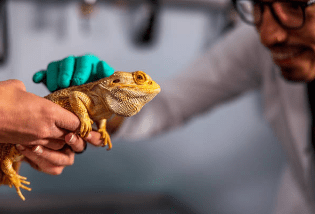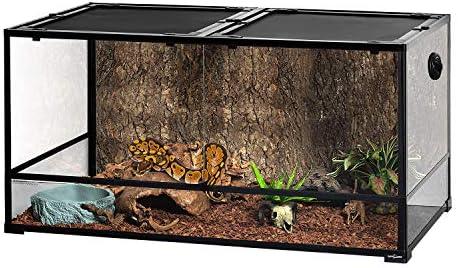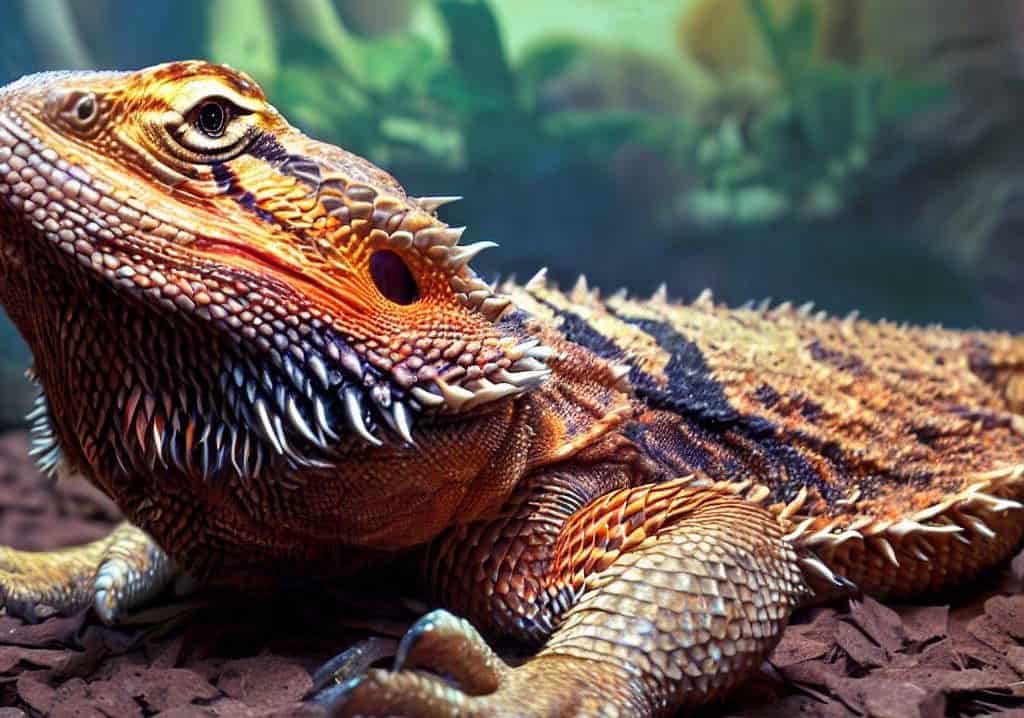Greetings, fellow herpetology enthusiasts!
In this article, we’re exploring a topic that can make any bearded dragon owner’s scales—well, skin—crawl: scale rot.
This nasty condition can compromise your dragon’s health and comfort.
So grab your note-taking gear, because you won’t want to miss this valuable information.
Table of Contents
Understanding Scale Rot: What is this Bearded Dragon’s Hidden Enemy?
Ah, scale rot, the sneaky adversary of bearded dragons. But what exactly is it? Scale rot is a bacterial infection that targets your bearded dragon’s scales. Not just a superficial issue, it can lead to systemic health problems if neglected.
So, let’s lift the veil on this hidden enemy:
- Bacterial Culprit: At its core, this ailment usually comes from the bacterium Aeromonas hydrophila.
- Scales and Skin: The infection primarily affects the scales, making them an obvious area for your concern.
- Serious Business: Don’t sleep on it; this can escalate into severe complications if not addressed promptly.
Observation of Symptoms and Early Detection of Scale Rot in Bearded Dragons
Before you can treat scale rot, you must first know how to spot it. Early detection is your closest ally in the fight against this nasty condition. Let’s delve into the specifics of the signs to look out for in your scaly sidekick.
Discoloration
If your dragon’s scales suddenly look like they’ve lost their luster or have darkened, take heed. The discoloration is often one of the first signs of impending scale rot in bearded dragons.
Swelling
Swollen areas on the body are like little red flags fluttering in the wind. They can indicate an underlying bacterial infection that’s manifesting as scale rot.
Peeling or Abnormal Shedding
Shedding is natural, but if it starts looking odd or peeling in weird patterns, it’s time to raise an eyebrow. Abnormal shedding can signify skin issues, potentially linked to scale rot.
Loss of Scales
If scales are falling off more than leaves in autumn, that’s a sign of advanced scale rot. Immediate attention is crucial to prevent further deterioration.
Redness or Irritation
Red or irritated skin areas are like flashing neon signs saying, “Hey, something’s wrong here!” They often indicate inflammation or infection and can be a precursor to scale rot.
Behavioral Changes
Finally, if your bearded dragon starts acting like it’s having a bad day (or week), take note. A grumpy or lethargic demeanor can also be a sign of discomfort caused by early scale rot.
Main Causes of Scale Rot in Bearded Dragons
Alright, let’s get to the root of the problem. Knowing the causes of scale rot can help you prevent future outbreaks.
Excessive Moisture
Too much of anything is bad, and that includes water in your bearded dragon’s environment. Excessive moisture can set the stage for bacterial growth, leading directly to bearded dragon scale rot. Keep that habitat dry to keep scale rot at bay.
Improper Enclosure Conditions
Your dragon’s living quarters should be more like a sanctuary and less like a petri dish. Unclean bedding, improper temperatures, and inadequate ventilation create a breeding ground for bacteria that can cause scale rot bearded dragon woes.
Poor Hygiene and Sanitation
You wouldn’t like to live in a filthy home; neither does your dragon. Poor hygiene and lack of regular cleaning create a haven for bacteria, posing a risk for early-scale rot in bearded dragons. Don’t let your dragon’s home turn into a bacteria theme park.
Trauma or Injury
Imagine having a cut and not cleaning it; that’s an invitation for bacteria. Any trauma or injuries to your dragon’s scales can act as a gateway for bacterial infection, escalating into scale rot if left unattended.
Incorrect Shedding
As with humans, skin issues for bearded dragons can be a nightmare. Incorrect or problematic shedding can leave behind patches of old skin, creating a delightful playground for harmful bacteria affecting the bearded dragon scales.
Nutritional Deficiencies
“You are what you eat,” and this saying applies to dragons too. A deficient diet can compromise your bearded dragon’s immune system, making it more susceptible to infections like scale rot bearded dragon issues.
Stress and Weakened Immune System
Even dragons have their breaking point. Chronic stress can weaken your bearded dragon’s immune system, leaving them vulnerable to ailments like scale rot. And let’s face it; a stressed dragon is not a happy dragon.
Physical Examination of Your Bearded Dragon
Assessing the condition of your bearded dragon’s scales is an integral part of any healthcare regimen. A thorough examination can point you in the right direction for effective treatment.
Visual Inspection
The first step is essentially your ‘first glance’ audit. This is where you look for visible signs like discoloration, redness, or swelling. You don’t have to be Sherlock Holmes, but a keen eye can detect early-scale rot in bearded dragons.
Skin and Scales Assessment
Next up is a tactile review. Gently feel the bearded dragon scales for texture, elasticity, and hidden issues like lumps or pus. This will give you a tangible sense of what’s going on beneath those scaly exteriors. It’s a tactile means of saying, “Hey, is everything okay under here?”
Examination of Affected Areas
If you’ve noticed any suspect areas, this is the time for a deep dive. Examine these spots for any signs of infection or discomfort. Pus, fluid, or an unusual odor could be red flags signaling bearded dragon scale rot.
Assessment of Shedding
Last but not least, review any recent shedding. If shedding is uneven or incomplete, it could indicate underlying skin issues, including scale rot. This step is like reading the final chapter of a book; it helps confirm any suspicions and shapes your next steps.
How to Treat and Cure Scale Rot?
Treatment is a multi-step endeavor, so let’s arm you with a game plan.
Clean and Disinfect the Affected Area
First things first—think of this step as a mini “spring cleaning” for your dragon’s scales. Use a diluted antiseptic solution to gently clean the infected areas. Remember, cleanliness is not just next to godliness; it’s the first line of defense against bearded dragon scale rot.
Topical Treatment
Once the area is clean, it’s time for topical treatment. Think of it as applying a protective shield. An antibiotic ointment or cream can help fight off bacteria and speed up the healing process. A small application can go a long way in tackling scale rot.
Medications: Cream and Antibiotics
Sometimes the infection needs a bit more firepower. Prescription creams or oral antibiotics can add that extra oomph to your fight against scale rot in bearded dragons. Always consult your vet for the right medication and dosage.
Supportive Care
Think of this as pampering your dragon with some TLC—Temperature, Love, and Care. Ensure their habitat is well-maintained, clean, and at the right temperature to help boost their immunity and speed up recovery.
Vet Follow-up Visits
These are your progress reports. Regular vet check-ups will help track the healing process and make any necessary adjustments to the treatment plan. Two heads—or, in this case, two species—are better than one.

Soaking
A little spa day never hurt anyone! Soaking your dragon in a shallow, warm bath can help in loosening any infected skin and providing relief. Just remember, we’re talking about soaking, not swimming.
Wound Care
If there are open sores or wounds, proper wound care is crucial. Treat these areas delicately with antiseptic solutions and keep them dry to avoid further infection.
Follow Hygiene Practices
Finally, maintaining good hygiene practices will not only help in treating scale rot but also prevent future outbreaks. Regular cleaning of the enclosure and keeping everything spick and span is your final shield against scale rot rearing its ugly head again.
7 Preventing Tips
Prevention is the best medicine, as they say. Here are the preventive measures you can adopt.
Proper Enclosure Setup
Make sure your dragon’s palace—err, enclosure—is up to snuff. A clean, well-ventilated space with the right substrate and decor can prevent many issues, including that pesky bearded dragon scale rot.

Maintain Optimal Hygiene
Your dragon can’t hold a broom, but you can! Regular cleaning of the enclosure, including substrate and decorations, keeps harmful bacteria at bay. Think of it as your dragon’s maid service, but without the frilly apron.
Adequate Humidity and Moisture Control
Humidity levels should be just right—Goldilocks-style. Too much moisture is a breeding ground for bacteria, but too little could lead to shedding issues. Striking that balance is key.
Regular Health Checks
Consider these your dragon’s check-up appointments, but at home. Frequent visual inspections and physical examinations can catch early-scale rot in bearded dragons and other health issues.
Balanced Diet and Nutrition
You are what you eat, and so is your dragon. A balanced diet rich in essential nutrients can boost the immune system and keep scale rot at bay. Think of it as fueling your dragon’s fire.
Prevent Injury and Trauma
Preventing accidents is like dragon-proofing your home. Make sure there are no sharp or hazardous objects that could cause injuries and open the door to bacterial infections.
Monitor Shedding Process
Keep an eye out during shedding season. Incomplete or abnormal shedding can become a hotbed for bacterial growth. Monitoring the process can help prevent complications, including scale rot.
Conclusion
Wow, that was a lot, but knowledge is power, right? You’re now well-equipped to handle scale rot in bearded dragons, from spotting early symptoms to executing a thorough treatment plan.
Remember, early detection and proactive measures can keep your scaly friend happy and healthy. Happy dragon parenting!
FAQs
How quickly can scale rot progress in bearded dragons?
Scale rot can advance rapidly if left untreated, often showing significant deterioration within a week. Immediate action and veterinary consultation are essential.
Can scale rot be completely cured?
Yes, scale rot can usually be fully cured with prompt and proper treatment, which often includes cleaning, medication, and improving enclosure conditions.
Is scale rot contagious to other bearded dragons or pets?
Scale rot itself is not contagious, but the bacteria causing it can spread to other bearded dragons or reptiles if hygiene practices are not maintained.
Alina Hartley is a small-town girl with a ginormous love of bearded dragons. It all started with Winchester, a baby bearded who was abandoned at the shelter by his former owners because of a birth defect that caused one front leg to be shorter than the other. Alina originally went to the shelter looking for a guinea pig, but one look at Winchester and it was love at first sight. From that day on, Alina has dedicated her life to learning everything she can about bearded dragons. She loves helping new beardie parents start their incredible journey with these magnificent reptiles.
Follow her on:
LINKEDIN
TWITTER.
Read her latest articles HERE
Learn more about her HERE.

